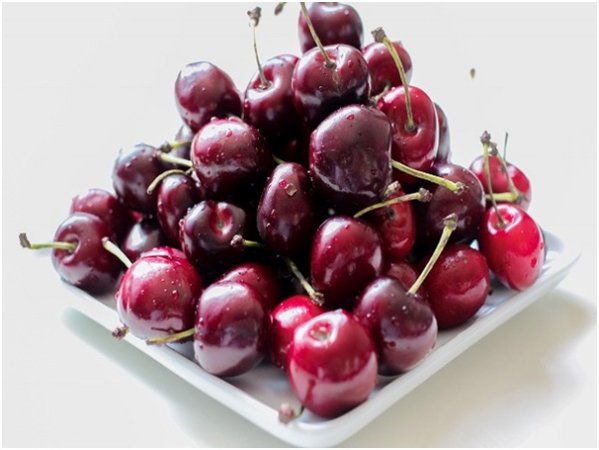A lot of the foods that we humans eat are quite safe for dogs to eat. However, it’s a bit more complicated when it comes to cherries. While they may have a lot of medicinal benefits, cherries can also cause various side-effects in dogs. Let’s take a look at some important things you should know before feeding your dog with this fruit.
Table of Contents
What Is A Cherry?
It is a fleshy stone fruit. It’s also the fruit of different genus prunus plants. The regular ones we eat every day come from various species such as Prunus cerasus (sour cherry), and Prunus avium (sweet cherry). These species of cherry originate from Western Asia and Europe.
A cherry tree takes roughly two to four years to produce the first fruit crop and about six to seven years to fully mature. Depending on the region, harvest time for this fruit might be in June, mid-July, or mid-August.

The major commercial growers of this fruit in Europe are Spain, Southern Scandinavia, and Italy. In the Middle East, they are grown in Israel, Syria, Lebanon, and Iran. In the US this fruit is grown in Michigan, Oregon, Wisconsin, California, and Washington.
The most popular cherry cultivars are Rainer, Maraschino, Ulster, and Bing. Each type has different levels of sweetness. In the US alone, over a thousand different varieties of cherry fruits are grown.
With the exception of the Northern Territory, this fruit is grown in every state of Australia. The major growers are Southern Australia, South Wales, Victoria, and Tasmania.
The sweet and sour varieties have different nutritional values. They all contain vitamin C; however, sour cherries have fifty percent more vitamin C and about twenty times more vitamin A.
What Are Their Benefits?
This fruit is a great source of vitamin C, which is important for your skin health and your immune system. They are also rich in anti-inflammatory compounds, and antioxidants. Consumption of cherries has also been known to ease arthritis, boost muscle recovery, and improve sleep. Visit https://www.healthline.com/nutrition/cherries-benefits to learn more benefits of this fruit.
What Are the Downsides of Feeding a Dog Cherries?
Despite the numerous benefits of this fruit, they can be quite harmful to dogs. The stem, leaves, and pits of the cherry fruit contain cyanide. If eaten in large quantities, this compound will have negative effects on your dog. However, one cherry is not enough to cause any harmful effects.
As you probably already know, there are quite a lot of cherry varieties. One thing which all cherries have in common is sugar. Giving you dog more than one or two cherries at a time could result in a tummy-ache. Too much sugar will lead to digestive upset, diabetes, and of course, tooth cavities.
What Is Cyanide?
Cyanide is a deadly chemical which exits in a crystal or colorless (and sometimes odorless) gas. This compound is found in the seeds and pits of various common fruits such as peaches, apricots and cherries. Cyanide is used by manufacturers to create textiles and plastics. It is also used when making paper. This compound is toxic to both humans and dogs.
You can click here for more information on cyanide.
How Do You Make Cherries Safe for Dogs?
The first and most important thing you should never do is give your dog more than two cherries at a time. In order to prepare a cherry, you must remove all the leaves, as well as the stem and the pit, because they contain cyanide. If your dog will be taking this fruit often, this will take a lot of work. Besides, you probably won’t be giving your pet enough cherries for it to get a lot of the nutritional benefits.
What Do You Do If Your Pet Eats a Cherry Whole?
If your dog eats only a couple of cherry fruits with the pit and stem, the chances of developing any serious problem is very low. However, effects will vary depending on the dog. If you give cherries to your dog with its pit, it will release the cyanide contained in it, causing cyanide poisoning.
Some dogs may experience vomiting, diarrhea, lack of appetite, and constipation. This indicates that the intestine is blocked. In smaller dogs, it only takes one cherry pit to cause problems. If your pet has red gums, dilated pupils, and has trouble breathing, this could be a sign of cyanide poisoning. If your pet eats a cherry whole, it is advised that you consult a veterinarian even if your dog isn’t showing any symptoms.
What Alternatives are there to Cherries?
Fruits such as apples, blueberries, and mangoes are great alternatives to the cherry fruit. Apples are another option, but you need to keep in mind that the seeds contain a compound that releases cyanide into the body when chewed.
Apple seeds don’t contain enough cyanide to cause any damage but you should remove the seeds just to be on the safe side. Aside from being safer for dogs, these fruits are also packed with nutrients similar to those of cherries. Alternatively, you can stick to using regular dog treats.
Conclusion
Not all human foods are safe for dogs. The cherry fruit is a good example. If it isn’t carefully prepared and rationed, it will have negative effects on your dog’s health. On the bright side, cherries are a great nutritious treat when carefully prepared. However, it’s important that you exercise caution when feeding your dog this fruit.




